The 33nd ULVAC-PHI Show & Technical Lecture
2016.10.21 Update
The 33nd ULVAC-PHI Show & Technical Lecture

On June 1, 2016, ULVAC-PHI held the annual ULVAC-PHI Show & Technical Lecture at the AIJ Building in Tokyo.
The event was a full house with many attendees taking notes while listening closely to the lectures and actively participating in the question-and-answer session.
In the morning session, ULVAC-PHI gave two presentations.
Introduction of New Products and Technologies
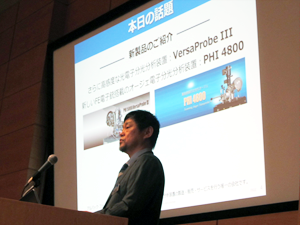
Katsumi Watanabe of ULVAC-PHI’s Research & Development Department introduced, using actual data, the “PHI 5000 VersaProbe III,” which accomplished higher sensitivities for both micro and large area analyses through XPS (X-ray Photoelectron Spectroscopy), the “PHI 4800,” a new AES (Auger Electron Spectroscopy) instrument that excels at analyzing chemical states of submicron areas which cannot be covered by the XPS micro analysis, and “PHI Quantes,” a laboratory-use hard X-ray photoelectron spectrometer, under development, with unique features which cannot be obtained by conventional XPS.
Latest Application Using Parallel Imaging MS/MS
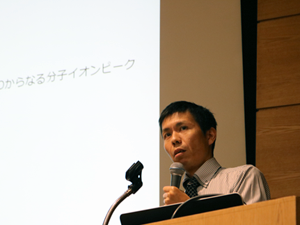
Shinichi Iida, a member of ULVAC-PHI’s analytical laboratory, explained the latest option for the PHI nanoTOF II, MS/MS, currently under development. Conventionally, the difficulty of spectral analysis using the TOF-SIMS was an issue. However, the MS/MS option enables easy access to obtaining information on chemical structures and peak identification. The presentation also included application enabling relegation of materials.
In the afternoon, guest lecturers, from various fields, gave presentations on various topics ranging from the history of the development of surface analysis with current evaluation techniques to the latest research studies.
History and Mechanism of Charge Relaxation
Working on Surface Analysis of Actual Materials & Future Expectations
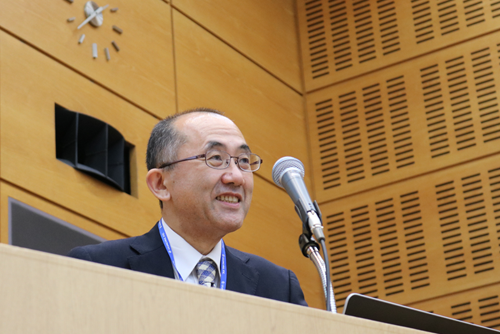
Mr. Kazunari Shiozawa
MITSUI CHEMICAL ANALYSIS & CONSULTING SERVICE, INC.
Mr. Shiozawa gave a presentation on how the use of non-monochromatic X-ray sources changed to monochromatic X-ray sources in XPS along with the problem of non-uniformly charged samples and its charge relaxation method.
While focused monochromatic X-ray sources reduce damages to samples, it also causes non-uniform charges, commonly seen with spot irradiation. Based on his experience in analyzing, he explained it is insufficient just with electrons and the problem will be solved by also adding positive electric charge (argon ions).
He also expressed his expectations for charge relaxation of the laboratory-use HAXPES.
Appropriate Selection of Systems and Highly Accurate Evaluation
Utilization and Prospects of Photoelectron Spectroscopy at Kobelco Research Institute, Inc.
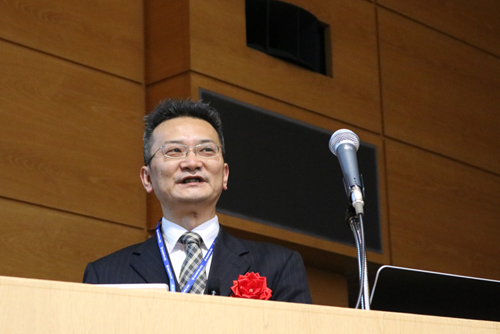
Mr. Masayuki Inaba
Kobelco Research Institute, Inc.
“We would always like to propose solutions that best meet the customers’ needs by catching up with the constantly-evolving technologies and seeking adequate use of them,” says Mr. Inaba who gave a presentation on actual evaluation results of battery materials.
The presentation included qualitative analysis of sample surface unexposed to air to reduce deterioration, depth profiling using the gas cluster ion beam (GCIB) to reduce deterioration, non-destructive valence band analysis of cathode active materials using HAXPES, and detailed analysis of Si anodes, based on the perspective of the importance choosing the adequate method for the materials or purpose.
Controlling Interface on a Molecular Level
Control of the Surface & Interface Structures of Organic Semiconductor Thin Films and Application to Organic Electronic Devices
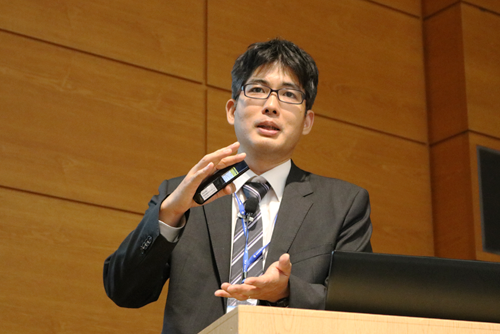
Dr. Keisuke Tajima
RIKEN CEMS and JST PRESTO (Sakigake)
Dr. Tajima introduced their latest research results on organic semiconductor devices, recently applied in various fields.
After explaining the background of the importance of controlling interface structures accurately for obtaining desired features, he presented a completely new method of mounting the functional surface of a monomolecular film with a controlled molecular orientation on an interface. The presentation also introduced surface analysis applications on organic device materials, including evaluation of the distribution of concentrations in depth using XPS for angular resolution measurement and measurement of ionization potential using UPS as evaluation methods of thin films.
Application of Surface Analysis to Actual Operating Environments
Genealogy and Prospect of Operando Surface Nano-Characterization
—from Graphene to Next-Generation Batteries—
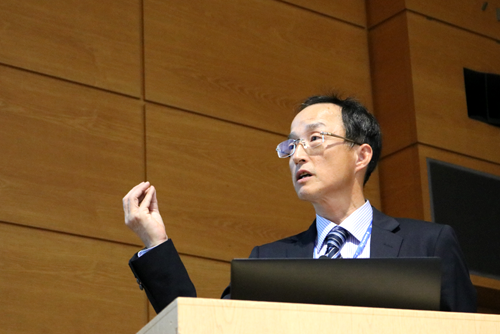
Dr. Daisuke Fujita
National Institute for Materials Science (NIMS)
While “operando measurement,” a technique that measures devices in their operating condition, has been receiving attention, Dr. Fujita from NIMS, a long-time leader in developing and disseminating measurement technologies of nano-characterization, explained the application of operando measurements to surface analysis.
The presentation started with the application of using XPS to observe the formation of graphene on metal film surface under heating, followed by the application of scanning probe microscope for observing density of state distribution in next-generation solar batteries and the comparison of potential distributions of lithium battery electrodes between charging and discharging states.


